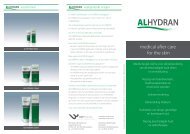You also want an ePaper? Increase the reach of your titles
YUMPU automatically turns print PDFs into web optimized ePapers that Google loves.
ing environment (see second article in thissupplement). While ‘optimal’ in this context has yetto be fully defined, it is vital that the chosen <strong>dressing</strong>not only provides a relatively constant level of moistureat the wound-<strong>dressing</strong> interface but also absorbsand binds any excess exudate. Contemporaryapproaches offer distinct advantages over conventional<strong>dressing</strong> technology, which was unable toachieve this.Fluid-handling mechanismsAbsorbencyBecause of the heterogeneous nature of wounds(and exudate), <strong>dressing</strong> selection should correlatenot only to the size and type of wound, but also tothe nature, volume and viscosity of the exudatepresent. 14 The management of highly exuding pressureulcers poses two additional problems:• Prevention of secondary damage caused by highpoints of pressure between the support surface/<strong>dressing</strong> interface and underlying soft tissues• The binding of the fluid within the <strong>dressing</strong>matrix when the <strong>dressing</strong> is place undercompression.The first problem requires the careful selection ofmaterials that can conform and spread the pressureload while retaining their integrity.Excess exudation can have serious consequencesfor wound healing. Once the absorbent capacity ofany <strong>dressing</strong> used has been reached, fluid may leakthrough or around the <strong>dressing</strong> material. Thisallows exudate to spread further from the woundand provides a route for bacterial ingress, increasingthe risk of infection to the patient or the spreadof bacteria to other individuals. For the sufferer,sodden, soiled <strong>dressing</strong>s are embarrassing and canlead to chronic social isolation as she/he shies awayfrom even family and friends. This social exclusioncan have negative impacts on healing outcomes. 15The selected <strong>dressing</strong> should be able to absorb ahigh volume of fluid in relation to its physicaldimensions. This is particularly important if it is tobe used on moderately to highly exuding wounds,which typically produce approximately 5ml per10cm 2 per 24 hours. 16It has been suggested that polyurethane foams,alginates and Hydrofiber are suitable for highlyexuding wounds. 17 Nevertheless, limitations existin their clinical <strong>performance</strong>. In my clinical experience,polyurethane foams are unable to absorb andretain large volumes of exudate for extended periodsand appear to be more relevant for low tomoderate levels. Despite their popularity, one publicationstates that polyurethane foams have notshown any advantages over gauze in healing times,patient satisfaction, costs or length of hospital stay,and there is no proof in the literature of a consistentadvantage over other non-gauze <strong>dressing</strong>s. 18Alginates are derived from brown seaweed. Theircomposition influences the degree of alginate fibregelling that takes place 19 and, hence, maintenanceof the overall <strong>dressing</strong> integrity. Although they canabsorb up to 20 times their weight in wound fluid,absorption capacity is limited as a 10x10cm alginate<strong>dressing</strong> weighs a mere 1g. Absorption capacityis further reduced under compression. 19Hydrofiber is a fibrous material made fromsodium carboxymethylcellulose, which forms a gelwhen in contact with wound exudate and plays avaluable role in avoiding/reducing wound deadspace. 20 Anecdotal evidence suggests that there maybe a loss of <strong>dressing</strong> integrity with Hydrofiber whenused under compression and that it has only aslightly higher absorbent capacity in relation to itsown weight than alginate.Polyurethane foams, alginates and Hydrofiber<strong>dressing</strong>s promote a moist wound environment andso have a role to play in wound management, butlike all <strong>dressing</strong>s limitations in <strong>performance</strong> exist.Retention of fluidCochrane (1990) stated that skin should be keptclean and dry to prevent maceration. 21 An important<strong>dressing</strong> <strong>performance</strong> parameter that extendsbeyond the mere volume absorbed is the <strong>dressing</strong>’sability to retain the exudate within its matrix. 11,22A sponge is able to readily take up fluid but isunable to hold it when compressed. A product thatcan expertly manage and retain ‘excess’ exudate isrequired. By preventing further moisture loss andthus desiccation, it will enhance re-epithelialisationand autolytic debridement. It must be possibleto use the product with other therapies, such ascompression bandaging, without compromisingefficacy or posing additional problems such aslocalised pressure damage. Finally, the productshould also be able to lock-in a significant volume(in the region of 100ml) of exudate without losingits structural integrity. A <strong>dressing</strong> that can absorband retain wound fluid will avoid the risk of overhydrationand/or maceration. 6Prevention of macerationProlonged exposure to excessive chronic woundexudate or its protease content will lead to wounddeterioration and potential skin breakdown. 23Excess moisture can lead to problems: over-hydrationof the surrounding skin results in macerationJ O U R N A L O F W O U N D C A R E S O R B I O N S U P P L E M E N T 2 0 1 07



